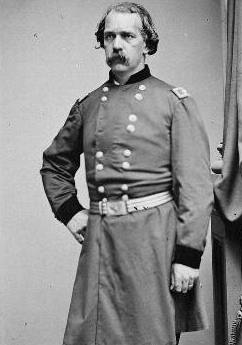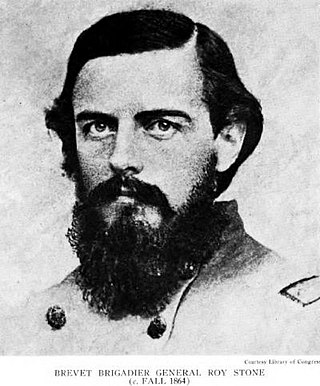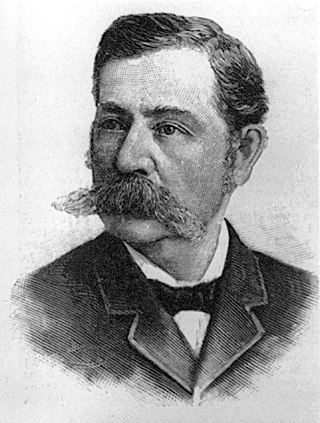Related Research Articles

John Henry Hobart Ward was an American soldier who fought in the Mexican–American War and in the American Civil War. Ward joined the army in 1842 and fought in multiple battles in the Mexican–American war, including the Battle of Monterrey, where he was wounded. After leaving the army, he served successively as the assistant commissary general and commissary general for the state of New York. With the outbreak of the American Civil War in 1861, Ward rejoined the army, and became the colonel of the 38th New York Infantry Regiment. Ward and his regiment were engaged in the First Battle of Bull Run and in several battles in the Peninsula campaign. He was promoted to command a brigade after the Battle of Chantilly in September 1862.

Roy Stone was an American soldier, civil engineer, and inventor. He served in the American Civil War, distinguishing himself during the Battle of Gettysburg, and took part in the Spanish–American War. He pursued a civil engineering career in a peacetime and became in 1893 the first head of the Office of Road Inquiry, which was the Federal Highway Administration's predecessor.
The bibliography of the American Civil War comprises books that deal in large part with the American Civil War. There are over 60,000 books on the war, with more appearing each month. Authors James Lincoln Collier and Christopher Collier stated in 2012, "No event in American history has been so thoroughly studied, not merely by historians, but by tens of thousands of other Americans who have made the war their hobby. Perhaps a hundred thousand books have been published about the Civil War."

Theodore Runyon was an American politician, diplomat, and American Civil War brigadier general in the New Jersey Militia, serving with the Union Army at the Battle of First Bull Run. Runyon was a lawyer before the Civil War and mayor of Newark, New Jersey, a major general in command of the New Jersey National Guard until 1873, first president of the Manufacturers' National Bank of Newark, chancellor of New Jersey for 14 years and, between 1893 and 1896, envoy and later ambassador to Germany.

The state of Rhode Island during the American Civil War remained loyal to the Union, as did the other states of New England. Rhode Island furnished 25,236 fighting men to the Union Army, of which 1,685 died. The state used its industrial capacity to supply the Union Army with the materials needed to win the war. Rhode Island's continued growth and modernization led to the creation of an urban mass transit system and improved health and sanitation programs.

Patrick Henry Jones was an American lawyer, public servant and Postmaster of New York City during the mid-to late 19th century. In 1878, he was involved in the Alexander T. Stewart bodysnatching case when he was contacted by the kidnappers to act as an intermediary between themselves and the Stewart estate. When negotiations stalled between the Stewart family's lawyer Henry Hilton, he assisted Stewart's widow in negotiating for the return of her husband's body.

John Donelson Martin (1830–1862) was a Confederate States Army officer during the American Civil War.
The 41st Regiment Massachusetts Volunteer Infantry was a three-year infantry regiment that served in the Union Army during the American Civil War. It was recruited as part of Governors Banks' and Andrew's recruitment drives to supply the union with a military force to hold and expand Union control of the lower Mississippi. In the late winter/early spring of 1863, it was converted to mounted infantry and later to cavalry. On its conversion in June 1863 at Port Hudson, it was disestablished and re-established as the 3rd Massachusetts Volunteer Cavalry.

The 9th Louisiana Infantry Regiment or Louisiana Tigers was the common nickname for certain infantry troops from the state of Louisiana in the Confederate States Army during the American Civil War. Originally applied to a specific company, the nickname expanded to a battalion, then to a brigade, and eventually to all Louisiana troops within the Army of Northern Virginia. Although the exact composition of the Louisiana Tigers changed as the war progressed, they developed a reputation as fearless, hard-fighting shock troops.
The following list is a bibliography of American Civil War Confederate military unit histories and are generally available through inter-library loan. More details on each book are available at WorldCat. For an overall national view, see Bibliography of the American Civil War. For histories of the Union, see Bibliography of American Civil War Union military unit histories. For a guide to web sources see: Carter, Alice E.; Jensen, Richard. The Civil War on the Web: A Guide to the Very Best Sites—Completely Revised and Updated (2003).
The following list is a Bibliography of American Civil War Union military unit histories. More details on each book are available at WorldCat.

Miles' Legion was a unit of the Confederate Army during the American Civil War. It was commanded by Colonel William R. Miles. The unit was officially named the 32nd Louisiana Infantry Regiment but it was never referred to by that name. The legion fought at the Battle of Plains Store and the Siege of Port Hudson. Captured at Port Hudson, the men were paroled, and the legion was declared exchanged in fall 1863. Many of the exchanged men never returned to duty. Those who did return joined Gober's Mounted Infantry Regiment or the 15th Louisiana Sharpshooter Battalion.

William Hopkins Morris was an American soldier, an officer in the United States Army, author, editor, and inventor. He served as a brigadier general of volunteers in the Union Army during the American Civil War.
The action at Abraham's Creek was an engagement on September 13, 1864 between Union Army and Confederate States Army forces during a Union reconnaissance in force toward Winchester, Virginia. The action occurred during skirmishing, maneuvering and scouting before the Third Battle of Winchester on September 19, 1864 in the Valley Campaigns of 1864 during the American Civil War. The Union force successfully completed the mission and captured about 173 Confederate prisoners.

The 154th New York Infantry Regiment was an infantry regiment in the U.S. Army during the American Civil War.

The 116th New York Infantry Regiment was an infantry regiment in the Union Army during the American Civil War.
The 5th Louisiana Infantry Regiment was a unit of volunteers recruited in Louisiana that fought in the Confederate States Army during the American Civil War. Formed in June 1861, the regiment was sent to fight in the Eastern Theater of the American Civil War. The regiment served at Yorktown, White Oak Swamp, Cedar Mountain, Second Bull Run, Harpers Ferry, Antietam, and Fredericksburg in 1862. The regiment fought at Chancellorsville, Second Winchester, and Gettysburg in 1863. At Rappahannock Station in November 1863, virtually the whole regiment was captured. The unit's remnant fought at the Wilderness, Spotsylvania, Cold Harbor, and the Valley campaigns of 1864. It served at Petersburg starting in December 1864 and a mere handful surrendered at Appomattox in April 1865.

The 14th Louisiana Infantry Regiment was a unit of volunteers recruited in Louisiana that fought in the Confederate States Army during the American Civil War. Formed in June 1861 as the 1st Regiment, Polish Brigade, the unit was later accepted into Confederate service as the 13th Regiment. After being sent to fight in the Eastern Theater of the American Civil War, it was renamed the 14th Regiment. In 1862, it fought at Yorktown, Williamsburg, Seven Pines, Beaver Dam Creek, Gaines' Mill and Glendale. At Glendale, the unit suffered a severe number of casualties and, thereafter, surviving members of the regiment dubbed the battle "the Slaughterhouse."

The 15th Louisiana Infantry Regiment was a unit of volunteers recruited in Louisiana that fought in the Confederate States Army during the American Civil War. Formed in June 1861 as the 2nd Regiment, Polish Brigade, the unit was sent to fight in the Eastern Theater of the American Civil War. As the 3rd Louisiana Infantry Battalion, the unit served at Beaver Dam Creek and Glendale. After two companies from the 7th Louisiana Infantry Battalion were added in July 1862, the unit reorganized as the 15th Louisiana Infantry Regiment. It joined the 2nd Louisiana Brigade and fought at Cedar Mountain, Second Bull Run, Antietam, and Fredericksburg in 1862. It served at Chancellorsville, Second Winchester, Gettysburg, and Mine Run in 1863. The regiment fought at the Wilderness, Spotsylvania, Cold Harbor, Monocacy, Third Winchester, Fisher's Hill, Cedar Creek, and Petersburg in 1864. A handful of survivors surrendered at Appomattox in 1865.

The 30th Louisiana Infantry Regiment was a unit of volunteers recruited in Louisiana that fought in the Confederate States Army during the American Civil War. On 17 December 1861, the Sumter Regiment was accepted into state service at New Orleans. On 1 March 1862, the militia regiment transferred to Confederate service for a 90-day enlistment. At the Capture of New Orleans on 25 April, three and a half companies stayed in the city and were captured. The other companies went to Camp Moore where the regiment reorganized for Confederate service on 15 May 1862, by the addition of four more companies. Company K left on furlough and never returned. The regiment fought at Baton Rouge before being assigned to garrison Port Hudson. On 4 March 1863, two companies were suppressed and their men reassigned to other companies, officially reducing the regiment to a 7-company unit named the 30th Louisiana Infantry Battalion. However, contemporary records often continued to refer to the unit as a regiment. A detachment was captured at the Siege of Port Hudson, but the bulk of the battalion served at Jackson in 1863, and New Hope Church, Atlanta, Ezra Church, and Nashville in 1864. The survivors were consolidated with the remnants of the 4th and 13th Louisiana Infantry Regiments, and the 14th Louisiana Battalion in February 1864. The men fought at Spanish Fort in March and April 1865, and surrendered in May 1865.
References
- 1 2 3 4 Place, Rich (August 2, 2014). "Civil War descendants gather for annual reunion". Salamanca Press . Retrieved February 10, 2015.
- ↑ "Reporters' Notebook". Buffalo News . July 20, 2014. Retrieved February 10, 2015.
- ↑ "Interview: Civil War Historian Mark H. Dunkelman". Blog 4 History. April 7, 2007. Retrieved February 10, 2015.